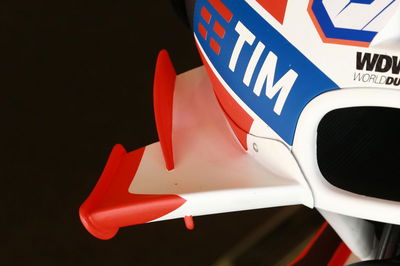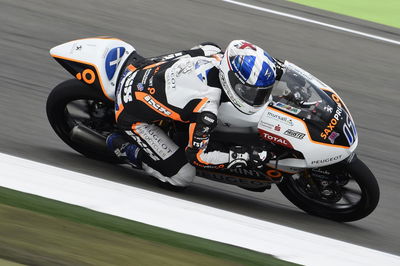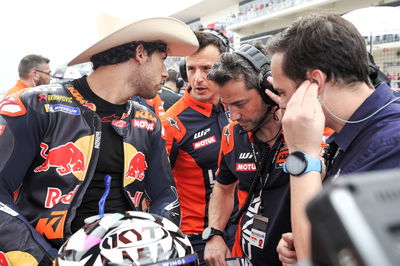Why wings were banned in MotoGP

At Assen, MotoGP's Grand Prix Commission announced that aerodynamic winglets will be banned from 2017.
The downforce generated by winglets helps resist the natural tendency of a motorcycle to wheelie under acceleration, which means less use of anti-wheelie electronics and more engine output.
However safety concerns have been raised about the possibility of injury if a winglet strikes a rider during an accident, while the downstream turbulence has caused some instability issues for following competitors.
All five manufacturers now have winglets available, in various stages of refinement, but the ruling means they cannot be used beyond the Valencia season finale.
Here we take a look at the factors leading up to the ban and why Ducati is angry at the decision.
 |
| A new era begins: Small winglets appear on Andrea Dovizioso's Ducati at the 2015 Qatar pre-season test. |
Ducati debuted the latest generation of MotoGP winglets at the 2015 Qatar pre-season test. The devices were modified during the season, while its rivals began playing catch-up behind closed doors.
Yamaha gave their winglets a grand prix debut at Misano in September, with Honda waiting until winter testing. Aprilia and Suzuki showed their designs at Jerez in April.
But by that time discussions were already underway about banning the devices.
"The alarm rang because in the Safety Commission the riders complained about them," MotoGP's director of technology Corrado Cecchinelli told Crash.net. "With this input from the riders, the FIM cannot just go on like nothing.
"They had to say 'ok, we have a complaint, so we have a concern. Which doesn't mean an issue, but you manufacturers need to tell us we should not worry'. The manufacturers could not do that."
 |
| By 2016 Ducati's winglets had become far more integrated, with several different specifications to suit different circuits. Here they are in maximum downforce configuration. |
Given the safety concerns raised by the riders, plus the secondary issue of cost, the FIM had asked the manufacturers' association (MSMA) to draw up a unanimous proposal - agreed by all MotoGP manufacturers - for the future of winglets.
This proposal was expected to include aspects such as limits on the size, shape, location and materials, plus assurances over safe detachment in the event of an accident.
"The FIM asked MSMA to make a unanimous proposal; make them safe and officially accept them," Cecchinello confirmed. "They gave MSMA some time, which was extended until here [Assen]. But this proposal didn't come and so the Grand Prix Commission decided to ban wings from next season."
 |
| Winglets on Marc Marquez's Honda |
"It was impossible to reach an agreement with the other factories," Ducati team manager Davide Tardozzi told Crash.net. "If the MSMA had reached a unanimous agreement and it went to the Grand Prix Commission, this proposal would have gone through. But not having a proposal, the Grand Prix Commission did what they thought was in the interest of the championship [and banned wings]."
 |
| Yamaha's Jorge Lorenzo was the first rider to win a MotoGP race using winglets, at the 2015 Valencia title showdown |
It is clear that the only way winglets could continue in MotoGP was if the manufacturers reached unanimous agreement on a proposal.
But if there was no proposal - as turned out to be the case - the Grand Prix Commission [FIM, Dorna, MSMA and IRTA] would hold a straight 'yes/no' vote on banning the devices.
And if the manufacturers themselves couldn't confirm the safety of their winglets, via a unanimous proposal, there is no way the Commission would vote to keep them.
"The FIM were starting from a position that was in favour of banning because of the safety concerns and cost issues," Cecchinelli said.
 |
| Aprilia winglets |
The controversy arises over whether all manufacturers were genuinely committed to reaching a winglet agreement within the MSMA, and whether the main issue became performance rather than safety.
Given that the absence of a unanimously-backed MSMA proposal would trigger a vote on banning winglets in the Grand Prix Commission, any manufacturer(s) seeking such an outcome could simply refuse to agree to a proposal.
"You have to ask them why they didn't want to reach an agreement. To me, the problem seems that it is not a matter of safety, as was the purpose at the beginning," Tardozzi said.
"I mean, after Argentina [where Iannone's wing made contact with Marquez at turn one] and all the discussion and complaints we proposed to have an agreement looking at the safety. We did a lot of work and brought a lot of documents to show what is safer, what is not safer.
"But in the end it seems that our work was for nothing. Because in the end everybody was looking at the performance, not at the safety. Then it was not anymore a matter to discuss about safety, but a matter to discuss about performance. That's something that we didn't appreciate."
 |
Ducati Corse general manager Gigi Dall'Igna also suggested that the failure to reach a deal within the MSMA had been motivated by a desire to neutralise Ducati's aerodynamic advantage:
"If things are not done correctly on a sporting level, I'm not a happy man. The motivation for the [ban on winglets] is being tied to safety, but winglets have never been a problem in this respect.
"We have carried out independently certified studies and tests, including with technical suppliers. We made a reasoned, well thought out proposal, which had been shared by the Japanese [in the MSMA] - who then changed their mind on it.
"So this leaves me rather disconcerted. The Japanese believe Ducati has developed its bikes with winglets and for this reason they think we have an advantage with respect to them, who developed their winglets afterwards."
Tardozzi added: "It is a shame, obviously. Ducati brought something new to the championship, moving MotoGP forward through research and development. The proof that winglets work is that all the other factories have followed our idea.
"Technical development in MotoGP is good for the road bikes of the future. That is the purpose of MotoGP.
"Obviously starting first, we think we are a bit ahead of the others [with winglets]. Now we have to stop. In the end it is even a matter of [staff], because we hired engineers to work on winglets and now we are forced to cut."
 |
Cecchinelli accepted that the process could be viewed as weighted in favour of any manufacturer(s) wanting to ban wings, but explained the safety angle meant MotoGP had to insist on unanimous MSMA agreement.
"It is clear that in the presence of safety concerns - if not issues - the correct FIM position is 'ok, they are banned as long as you don't do anything or tell me they are not dangerous'. This safety assurance didn't happen, and so to me the decision was correct.
"But this was not a general case.
"A different example would be something that one manufacturer has that others don't. Like the Desmo [valve] system. There is no discussion about banning that. The discussion about wings started from the Safety Commission where riders complained about them. That was the first attention point.
"If you take just the form of the process, yes you are right [that theoretically one manufacturer could secure a vote to ban wings by refusing to agree to any proposal], but the substance is that this is only under discussion because there are safety concerns.
"To me it is correct that the FIM take the position of banning them as long as the manufacturers don't agree on a statement that says 'in these conditions they are safe'."
 |
There is no doubt that winglets are fully legal under the present MotoGP rules, so does Cecchinelli feel any sympathy for Ducati?
"I think they are right to have an advantage in terms of their winglets - and should be respected - because they were the first ones [to develop winglets] and under regulations that allowed them.
"But as a technician I can tell you that in one year all the others can catch up. They wouldn't have any advantage from next year onwards, so I think [the ban] is a fair decision even from this respect.
"I agree that winglets should not be banned immediately; firstly because there is not a clear safety issue - there is a safety concern - and secondly because someone has an advantage under regulations that allow them."
 |
The last time a manufacturer introduced a new type of (expensive) technology, which all of its rivals were then forced to develop for performance reasons, was the Honda-led use of seamless-shift gearboxes in 2011.
And there is far less chance of a MotoGP-based seamless gearbox ever appearing on a road bike than a MotoGP winglet.
But again, safety is what makes the winglet situation different, although Cecchinelli conceded that if the ongoing costs of seamless gearboxes had been known they may also have been banned.
"They [seamless gearboxes] are different from the wings because no rider in the Safety Commission ever said the seamless gearbox is potentially dangerous," Cecchinelli said. "Probably it is potentially safer, because it's smoother. But let's say it doesn't make any difference on safety. This is the main difference.
"But, for me, still we should have been more careful at that time because the cost issue is huge for the seamless. So, to me, I'm not sure that was the right decision at the time. So I think it is good not to make the same mistake [with winglets], if it was a mistake.
"But the safety concern is the big difference between the two examples."
 |
Is it possible that Ducati will find a loophole in the new regulations and continue to use winglets, in modified form, next season?
"Winglets are banned. So that's it. We accept. That is the new rules. We have winglets until the end of the year and then next year's Desmosedici will be without winglets," insisted Tardozzi.
Nevertheless, given the amount of time, money and effort Ducati has invested, it would not be surprising to see engineers searching for a crack in the regulations.
"It is a very tricky matter. You can get to 90% of a perfect definition and this is what we did in Moto2 and Moto3," Cecchinelli said. "But in the end you leave to the technical director the last word on what a device is.
"So the regulation does it's best to make a definition of a wing and then it says it is up to the technical director to allow or not some device based on this definition.
"I took part in that definition, which to me is still fine, and so I don't see at the moment any reason to change it for MotoGP."
Wings were banned in the Moto3 and Moto2 classes earlier this season. The official description of a wing, which will now also apply to MotoGP in 2017, is as follows:
 |












